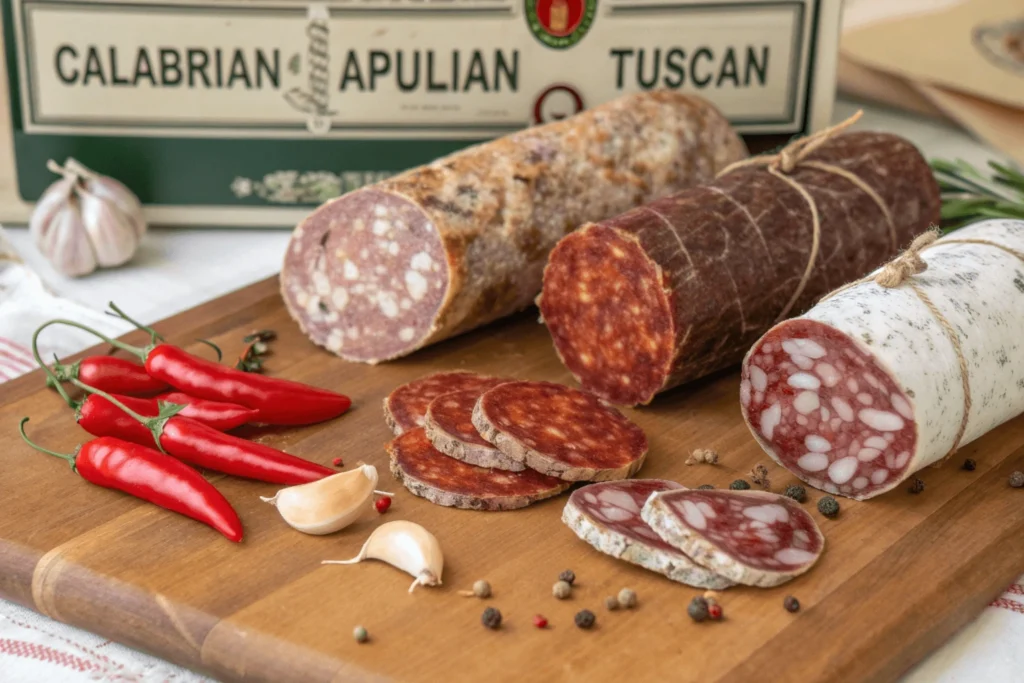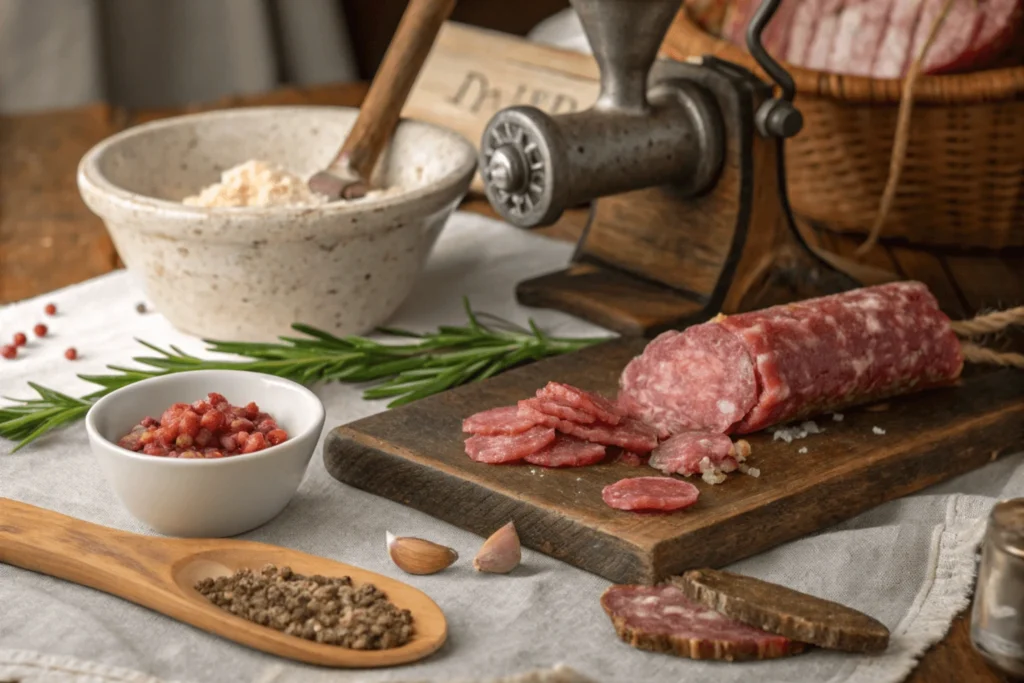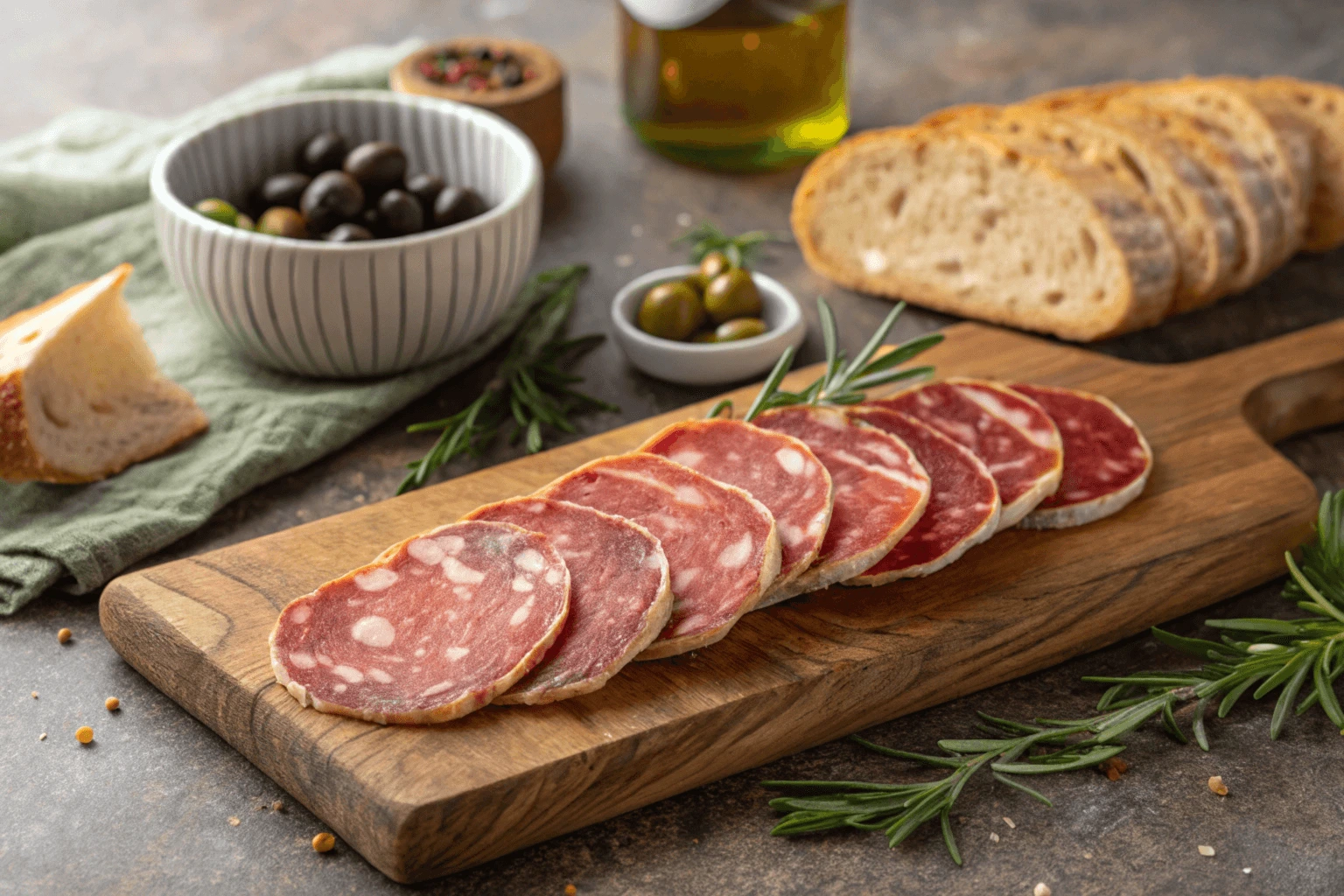Soppressata is a traditional Italian dry-cured pork salami made from coarsely ground meat, salt, and spices. Known for its bold flavor and rustic texture, it appears in both sweet and spicy varieties depending on the region. In this guide, you’ll learn what soppressata is, where it comes from, the different types, and how to enjoy it
Soppressata meaning: The name comes from the Italian word ‘soppressare,’ meaning ‘to press,’ referring to the traditional method of pressing the salami during curing.
Table of Contents
What Is Soppressata?
What Makes Soppressata Unique?
Soppressata stands out among cured meats for its bold flavor, artisanal preparation, and cultural significance. Unlike many other types of salami, is celebrated for its rustic and handcrafted nature. Its distinct characteristics make it a favorite among food enthusiasts and a must-have on charcuterie boards. Here’s what sets soppressata apart:

Flavor Profile
Soppressata boasts a rich, bold taste that balances the natural flavors of high-quality pork with the spices used in its preparation. Variants range from sweet and mild to intensely spicy, thanks to the addition of ingredients like black pepper, paprika, or even chili flakes. The curing process enhances its flavor, giving it a depth and complexity that rivals other cured meats.
Rustic Texture
What makes soppressata truly unique is its coarse texture. Unlike finely ground salamis, the meat and fat in soppressata are coarsely chopped, giving it a more robust and rustic mouthfeel. This texture not only adds to its artisanal charm but also makes it distinctively hearty when compared to other cured sausages.
Artisanal Craftsmanship
Traditional soppressata is often handcrafted by local artisans or families in Italy, following recipes that have been passed down through generations. Each region puts its own spin on the process, from the specific spice blends to the type of wood used for smoking (in smoked varieties). This dedication to tradition ensures that every bite of soppressata is steeped in history and culture.
Versatility in Use
is incredibly versatile. Its bold flavor and satisfying texture make it an excellent standalone snack, but it’s equally delicious when paired with cheeses, bread, or fruits. Its ability to elevate pasta dishes, pizzas, and sandwiches further adds to its uniqueness.
Connection to Italian Heritage
Finally, soppressata is deeply rooted in Italian culture, particularly in Southern Italy. It’s more than just food—it’s a symbol of tradition, often made during special occasions or family gatherings. Its name, derived from the Italian word “soppressare” (to press), reflects the traditional method of pressing the sausage for an even, compact shape.
Soppressata’s combination of rich flavors, unique texture, and cultural heritage makes it a standout cured meat, beloved by food lovers around the world.
What Does Soppressata Taste Like?
Soppressata has a bold, savory flavor with noticeable pork richness and a slightly tangy finish from the curing process. Spicy Calabrian varieties include chili heat, while sweet versions highlight the natural sweetness of the pork. The coarse texture gives it a hearty, rustic bite.
The Origins of Soppresata
it’s roots trace back to the rural regions of Southern Italy, particularly Calabria, Apulia, and Basilicata, where preserving meat was not just a culinary technique but a necessity. In an era before refrigeration, Italian farmers and villagers developed ingenious methods to extend the shelf life of pork by transforming it into flavorful cured meats, with soppressata becoming one of the most prized creations.
The name “soppressata” is believed to come from the Italian word soppressare, meaning “to press.” This refers to the traditional practice of pressing the sausage during the curing process. to achieve its characteristic flattened shape. This unique shape not only made it easier to store but also gave soppressata a distinct texture, setting it apart from other Italian salamis.
Each region developed its own take on soppressata, influenced by local ingredients and culinary traditions. For example, Calabrian soppressata is often spicy, made with generous amounts of chili peppers, reflecting the region’s love for bold and fiery flavors. On the other hand, Apulian soppressata tends to be milder and emphasizes the natural sweetness of the pork. In Tuscany, variations often include fennel seeds or black pepper for a more aromatic profile.
it was historically made as a family endeavor, with recipes passed down through generations. During the pig slaughter season, families would gather to prepare and season the meat, creating to last through the winter months. This communal process not only preserved food but also strengthened cultural ties, making soppressata a symbol of Italian heritage.
Today, while artisanal methods are still cherished, soppressata has gained international recognition and is produced on a larger scale. Despite modernization, traditional recipes remain highly valued, and many regions have secured Protected Designation of Origin (PDO) status to preserve the authenticity and cultural significance of their soprassetta
Understanding the origins of soprassetta provides a deeper appreciation for this timeless delicacy—a true testament to the ingenuity and passion of Italian culinary traditions.
Types of Soppressata
is not a one-size-fits-all cured meat; its flavors, textures, and preparation methods can vary widely depending on the region of Italy where it’s made. Here’s a closer look at the different types of soppressata, highlighting their unique characteristics:

Learn more about Italian cured meats and their rich history by visiting this detailed guide on traditional Italian salami.
1. Calabrian Sopressata
Calabria, a region in Southern Italy, is renowned for its bold and spicy foods, and Calabrian sopressata is no exception. This variation often incorporates Calabrian chili peppers, giving it a characteristic heat that sets it apart. The use of high-quality pork, a rich mix of spices, and traditional curing methods result in a flavorful, slightly spicy sausage with a deep red hue.
- Key Traits: Spicy, smoky, and intensely flavorful.
- Common Uses: Enjoyed on its own, paired with aged cheeses, or used to add a kick to pasta dishes.
2. Apulian Soppressata
Hailing from Apulia (Puglia), this type of soprssata leans toward a sweeter and milder flavor profile. The Apulian version typically uses coarsely ground pork and fewer spices, allowing the natural richness of the meat to shine. It’s often less spicy than its Calabrian counterpart, making it a great option for those who prefer a more delicate taste.
- Key Traits: Mild, rich, and slightly tangy.
- Common Uses: A popular addition to sandwiches or as a light appetizer.
3. Tuscan Soppressata
In Tuscany, soppressata takes on a unique twist. While still made from pork, the Tuscan version may include hints of garlic and aromatic herbs like rosemary or fennel seeds, giving it a distinctly earthy and savory flavor. The meat is finely ground, and the curing process often imparts a firmer texture.
- Key Traits: Herbaceous, aromatic, and firm.
- Common Uses: Paired with crusty bread and a glass of Chianti wine.
4. Sweet vs. Spicy Soppressata
Beyond regional distinctions, is broadly categorized into two main flavor profiles: sweet and spicy.
- Sweet Sopressata: Contains little to no chili pepper, focusing on the natural sweetness of the pork.
- Spicy Sopressata: Features a generous amount of crushed red pepper or chili, appealing to those who enjoy a bit of heat in their cured meats.
5. Artisanal vs. Commercial Soppressata
Finally, it’s worth noting the difference between artisanal and commercially produced soppressata. Artisanal varieties are typically made by small producers using traditional methods, resulting in more nuanced flavors and higher quality. Commercial soppresata, while still delicious, may have a more uniform taste due to standardized production techniques.
By understanding the types of soppresata, you can better appreciate the diversity of this Italian delicacy and choose the one that best suits your palate or cooking needs.
How Is Soppressata Made?
Traditional Preparation Methods
The traditional process begins with selecting high-quality pork cuts, typically shoulder and belly, finely ground to achieve the characteristic coarse texture. Artisans carefully blend the meat with salt, black peppercorns, and regional spices – often including garlic, red pepper, or fennel. Each region in Italy maintains distinct spice combinations that give their soppressata its unique character. The mixture is then stuffed into natural casings, traditionally pig intestines, using manual techniques that ensure proper density and minimal air pockets.
Curing and Aging Process
The curing phase starts with a 24-48 hour fermentation period at higher temperatures (around 75°F) to develop beneficial bacteria. The sausages are then moved to temperature-controlled rooms (50-60°F) with 65-75% humidity for dry-curing. This process typically takes 3-12 weeks, depending on the diameter and desired firmness. During aging, the soppressata develops its complex flavor profile through enzymatic breakdown of proteins and fats, while moisture slowly evaporates, concentrating the flavors and creating the firm texture.
Modern Production Practices
Commercial producers employ automated grinding and stuffing equipment, climate-controlled curing chambers, and standardized recipes to ensure consistency. While they follow similar basic principles, industrial methods often use:
- Starter cultures for controlled fermentation
- Synthetic casings for uniform size
- Accelerated curing techniques with precise humidity and temperature controls
- Standardized spice blends for consistent flavor profiles These modifications allow for larger-scale production while maintaining food safety standards, though purists argue this comes at the cost of traditional character and depth of flavor.

Soppressata in Italian Cuisine
As Part of a Charcuterie Board
- Traditional presentation includes thin-sliced sopressata arranged in a fan pattern
- Common accompaniments: aged Parmigiano-Reggiano, Pecorino Romano, marinated artichokes
- Wine pairings focus on Italian reds: Chianti’s acidity cuts through the meat’s richness, while Barbera’s fruit notes complement the spices
In Recipes and Dishes
- Pizza applications: diced as a premium topping, often paired with mushrooms or roasted peppers
- Pasta dishes: incorporated into carbonara variations or spicy arrabiata sauces
- Sandwiches: featured in classic Italian subs, particularly panini with fresh mozzarella and basil
Everyday vs. Gourmet Uses
- Casual applications: quick antipasto platters, lunch meat alternative, pizza topping
- Fine dining interpretations: hand-carved tableside service, ingredient in haute cuisine dishes
- Special occasion presentations: whole sopressata displayed at holiday tables, gifted during festivals
Tips for Buying, Storing, and Serving
How to Choose Quality
- Check for DOP certification on Italian imports, guaranteeing traditional production methods
- Select pieces with even white marbling and deep red meat
- Avoid specimens with gray spots, excessive mold, or off-odors
- Premium artisanal versions should have natural casings and minimal ingredients
- Verify the aging period—longer aging (3+ months) develops more complex flavors
Proper Storage Tips
- Store whole sopressata in a cool, dry place between 55-65°F
- Once cut, wrap tightly in butcher paper or wax paper, then foil
- Keep sliced sopressata in an airtight container in the refrigerator
- Use within 2 weeks after opening
- Allow refrigerated sopressata to reach room temperature before serving
Serving Suggestions
- Slice paper-thin (1-2mm) against the grain for optimal texture
- Pair with aged cheeses like Parmigiano-Reggiano or Pecorino
- Serve with crusty bread, olives, and roasted red peppers
- Include in charcuterie boards with other cured meats
- Create Italian sandwiches with fresh mozzarella and basil
FAQs
-
What is the difference between soppressata and salami?
While both sopressata and salami are cured meats, they differ in preparation, texture, and flavor. is typically made with coarsely ground pork, giving it a chunkier texture compared to the finer grind of traditional salami. Sopressata often has a bolder flavor profile, with variations ranging from sweet to spicy, depending on the region and spices used. Salami, on the other hand, is usually milder and more uniform in taste.
-
Is soppressata raw or cooked?
Soppressata is a cured meat, which means it is neither raw nor cooked but preserved through a process of fermentation and drying. The curing process removes moisture and develops the flavors, making it safe to eat without cooking.
-
Can you freeze soppressata?
Yes, sopressata can be frozen to extend its shelf life. Wrap it tightly in plastic wrap or aluminum foil, then place it in an airtight container or freezer bag. When ready to use, thaw it in the refrigerator for the best results. However, freezing may slightly alter its texture.
-
What are some common ways to serve soppressata?
Soppressata is incredibly versatile and can be served in various ways:
As part of a charcuterie board, paired with cheeses, olives, and crackers.
Thinly sliced and used as a topping for pizzas or sandwiches.
Diced and added to pasta dishes or salads for an extra burst of flavor. -
What wine pairs well with soppressata?
The wine pairing largely depends on the type of soppressata:
Spicy Soppressata: Pairs well with bold red wines like Chianti or Syrah, which can balance the heat.
Sweet Soppressata: Complements lighter wines like Pinot Grigio or a fruity rosé. -
Is soppressata gluten-free?
Most traditional soppressata recipes are naturally gluten-free as they primarily contain pork, spices, and natural casing. However, always check the label for any added fillers or seasonings that might contain gluten, especially with commercial brands.
-
How is sopressata pronounced?
Soppressata is pronounced as soh-press-SAH-tah. The name reflects its Italian origins and is derived from the word soppressare, meaning “to press,” which refers to its traditional preparation method.
-
Where can I buy authentic soppressata?
Authentic sopressata can be found at specialty Italian delis, gourmet markets, or online stores that focus on artisanal cured meats. Look for certifications like “DOP” (Denominazione di Origine Protetta) for assurance of quality and authenticity.
-
What makes artisanal soppressata special?
Artisanal sopressata is crafted using traditional methods, often passed down through generations. It typically uses high-quality pork, natural casing, and carefully selected spices. The curing process is done with care, resulting in a more complex flavor and texture compared to mass-produced varieties.
-
How long does sliced soppressata last in the fridge?
Sliced soppressata typically lasts 10–14 days in the refrigerator when tightly wrapped. Hot or spicy varieties follow the same storage timeline.
Conclusion
is more than just a delicious cured meat—it’s a rich part of Italy’s culinary history. Whether you’re savoring the spicy heat of Calabrian sopressata or enjoying the milder sweetness of Apulian varieties, this traditional sausage has something to offer everyone. From its artisanal production to its versatile use in various dishes, sopressata brings an authentic Italian flavor to your table.
By understanding the types of soppressata, how to properly store and serve it, and pairing it with the right wine or dishes, you can elevate your experience with this iconic cured meat. So, the next time you’re looking for a unique and flavorful ingredient for your charcuterie board, sandwich, or pasta dish, you’ll know exactly what to choose. Explore the world of soppressata, and don’t hesitate to try out some of the traditional recipes that highlight its bold taste.


